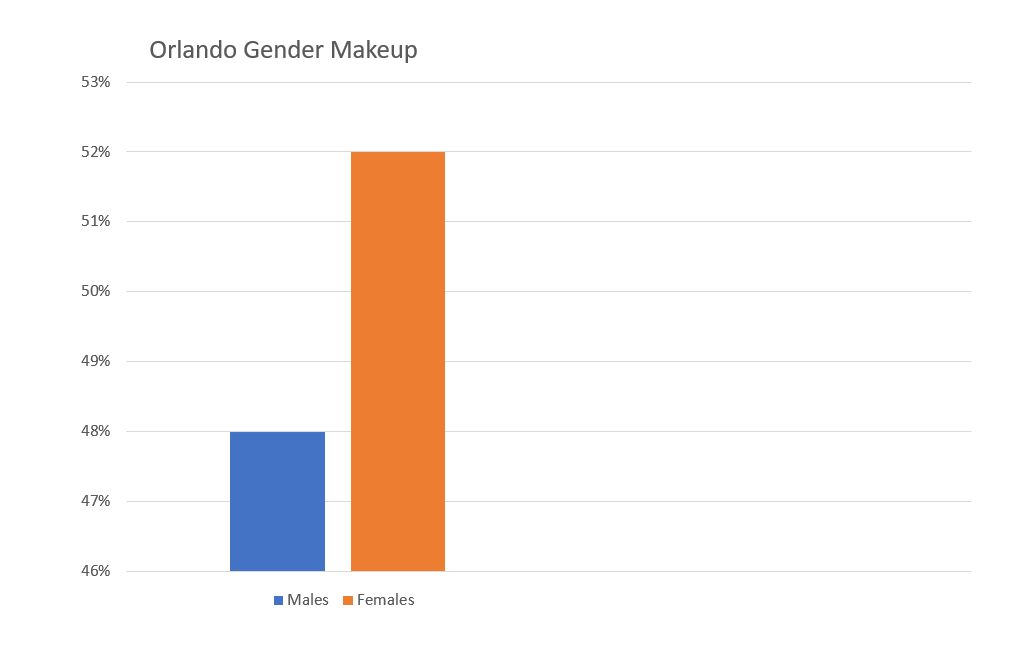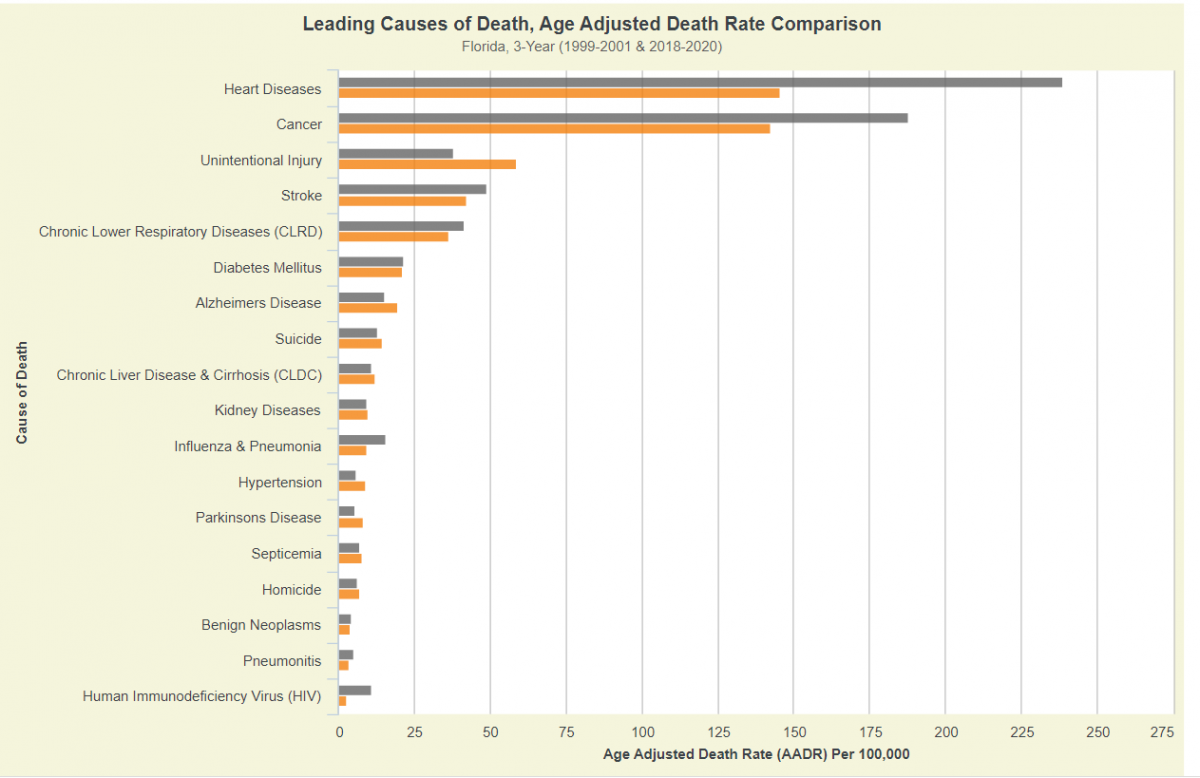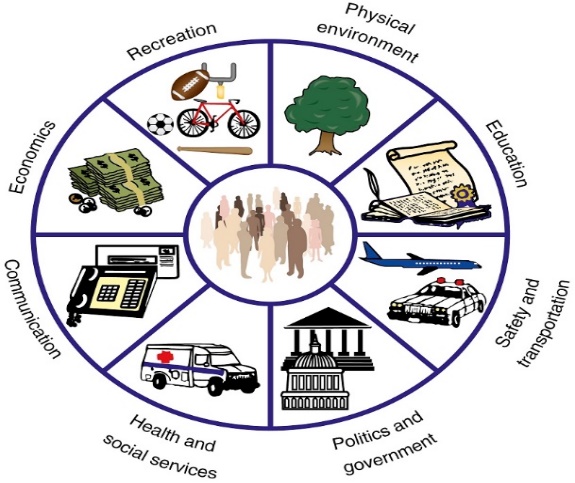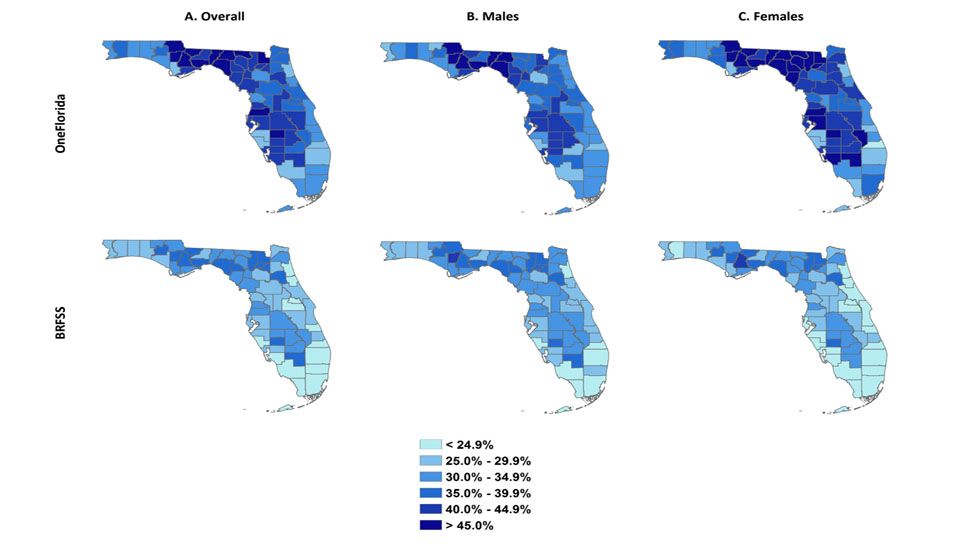Introduction
This community assessment will address the city of Orlando, Florida. It is a city in central Florida with a population of over 300,000 individuals (United States Census Bureau, 2021). It provides an overview of critical determinants for health as outlined by Healthy People 2030 program, and enable public health nurses to evaluate the community for potential interventions. It features a plan for potential intervention, including roles and responsibilities and community partners.
Population
Age, Gender and Race Distribution
Total population numbers of Orlando, Florida, as of April 1st, 2020, is 307,537 individuals. The age makeup of the city indicates a prevalence towards the middle, as 62% of these people are between 18 and 65 years of age. Geriatric population is at 10.2%, whereas children and teens stand for 27.8% of the total (United States Census Bureau, 2021).

When it comes to gender makeup, the population is divided relatively equally, with females having a slight advantage, being at 52%, with male individuals constituting the remaining 48%. This could be explained by the fact that women, on average, tend to live several years longer than men. This corresponds to the country’s average male to female ratio (United States Census Bureau, 2021).

Orlando is a predominantly white community, but many individuals of different races also live here. Whites alone constitute 61.3% of the population. The second largest group are blacks, with 24.5%. White Hispanics constitute 32.6% of the total. Asian-Americans and Natives are a relative minority, with 4.2% for the former and 0.2% for the latter (United States Census Bureau, 2021).

Biology and Genetics
Certain diseases often correspond to racial makeup of the population. Black populations are typically exposed to diabetes, sickle cell anemia, cancer, heart disease, stroke, asthma, pneumonia, and HIV/AIDS. Hispanic populations are more at risk for diabetes, hypertension, obesity, elevated low-density lipoprotein (LDL) cholesterol, low levels of high-density lipoprotein (HDL) cholesterol, and smoking. Asian-Americans are more likely to contract hepatitis B, liver cancer, tuberculosis, and lung cancer, among other conditions. Native Americans are at risk for chronic liver disease and cirrhosis, diabetes mellitus, unintentional injuries, assault/homicide, intentional self-harm/suicide, and chronic lower respiratory diseases. White non-Hispanic population is more likely to be affected by anemia, iron deficiency, arthritis, cancer, cardiovascular diseases, dementia, diabetes, and kidney diseases. Knowing this data as a PHN is important for predicting the likelihood of occurrence of certain diseases based on the population makeup. Based on the community census, diseases affecting white, black, and Hispanic populations are likely to be the most common.
Mortality and Morbidity Rates
Orlando city’s mortality and morbidity rates are not too different from state statistics. Florida saw 239,381 deaths in 2020, with the three top leading causes being heart disease, cancer, and COVID-19. These diseases alone account for over 100,000 deaths, with the other half associated with unintentional injuries, strokes, lung diseases, diabetes, and others (Florida Health, 2020).

Morbidity rates reflect mortality rates in that those causing the most damage are the ones most prevalent in the population. Throughout the year 2021, COVID-19 saw more emergence, even as death rates saw a relative decrease in relation to the number of incidents in the population. COVID-19 is the only pandemic currently affecting Orlando city (Florida Health, 2020).
Social Factors

Health Services
Orlando City offers a broad variety of healthcare services available to the population. These include primary care facilities, rehab facilities, LTC, assisted living, hospice care, mental health and home care, as well as various dental, vision, chiropractor, and alternative services. The majority of the facilities offering care operate in networks, which provide reimbursements to individuals possessing Medicare and Medicaid (“Healthcare,” 2022).
Access to Health Care
The majority of the communities in Orlando city have a primary care center or a kind of other medical facility within 15 minutes of their location. The majority of hospitals and large-scale medical centers is located near the center of the city. Physical access to healthcare, thus, is relatively robust. Availability of care to individuals with insurance and those eligible for Medicare and Medicaid is slightly higher than average in Florida and the US (“Access healthcare of Orlando,” 2022).
Social Services
Orlando city’s social services are presented by the Orange County Social Service Department, which is a government agency providing services for residents of the city. These include healthcare, human services, low-income programs and government benefits. They aim to assist children, the elderly, and vulnerable adults, especially women (“Orange County Social Service Department,” 2022). Besides government programs, there is also a food stamp program, shelter facilities, and several non-government agencies operating in the area. They assist the community by providing services and assistance to individuals that live below the poverty rate and/or experience problems beyond their ability to handle.
Safety and Transportation
The majority of Orlando’s population travels using cars. Public transportation is present, represented by buses and rail services. They are, however, limited, mirroring the situation in the majority of the US. Taxi services are represented by Uber and similar services. Car-sharing is available to the general populace as well (Visit Orlando, 2022). However, taxi services are expensive and cannot be relied on for regular transportation. The city has its own law enforcement, fire department, and emergency services present and in adequate condition to address the needs of the community.
Economics and Housing: Orlando city features low unemployment rates at about 4.5%, which is lower than that in the US, which is approximately at 6.5%. Average weekly wages vary between 850$ to 1100$, which is higher compared to the county and state levels. Leading industries in Orlando are trade, professional and business services, as well as education, leisure, and hospitality (“Orlando, FL, area economic summary,” 2022). Poverty levels are relatively high, with over 17% of individuals living in poverty, including a substantial number of children. Only 35% of people in Orlando city own their own house. Around 2,000 individuals are estimated to be homeless (“Orlando, FL, area economic summary,” 2022). The conditions of the available housing are not readily available.
Environment: Quality of air in Orlando city is considered reasonably good, with readings for the presence of pollutants varying between 2 to 9 μg/m³, depending on the month (IQAir, 2022). The primary toxin found in the air is PM2.5, which is dangerous in high concentrations, able to cause lung diseases, skin diseases, and cancer. The primary pollutant in the water is water algae (IQAir, 2022). Environment can significantly affect population health by facilitating the spread of diseases. Being a coastal city, Orlando is in danger of floods caused by hurricanes.
Recreation: Orlando city features 148 parks, gardens, recreational areas, and hobby centers to address the needs of the populace (City of Orlando, 2022). Cinemas, private entertainment establishments, and similar facilities are also present. Many of these do not require payment for entering, thus being available to the impoverished populations as well. Overall, the city features nearly any form of entertainment available state-wide (City of Orlando, 2022).
Education: Orlando city provides options for primary, secondary, and post-grad education. Graduation rates for the city in 2020 have been over 90%, though these parameters dropped after COVID-19 went into full swing (Postal, 2021). Special education is provided to individuals with limitation, and the availability of these services has been increasing since 2015. Schools typically feature wellness and health education programs, as well as physical education for children and teenagers. Free or reduced meal plans are available in some facilities. College accessibility is also slowly growing, especially for blacks, Hispanics, and impoverished families (Postal, 2021).
Policies and Government: The city adopts a liberal approach to policies regarding vaccination and immunization. In regards to COVID-19, Orlando city has a mandatory vaccination ban, meaning that employers and other authorities cannot force individuals to undergo vaccination (“COVID-19 latest information,” 2022). Masks and social distancing are considered optional. Nevertheless, these policies are not helping slow down COVID-19, as daily infections are at around 10,000 new cases a day (“COVID-19 latest information,” 2022).
Behavior: Smoking, inactivity, and obesity remain some of the biggest risk behaviors in Orlando city. These factors increased due to COVID-19 lockdowns. About 30% of all Orlando citizens are obese (“These are the top health concerns,” 2019). Drug usage is another risky behavior that is present in Orlando city. Positive factors include exercise, gym attendance, hiking, walking, and swimming, but those were limited by various mandates previously in place in the area. Healthy dieting is presented in several restaurants, but cheap fast foods remain popular among the population.

Vulnerable Populations: Vulnerable populations in Orlando city include homeless, migrants, and the poor. According to statistics, around 17% of the city’s population live at or below the poverty line. The city also has over 2,000 homeless individuals (“Orlando, FL, area economic summary,” 2022). They are exposed to the elements, hunger, drug addictions, and crime. The primary determinant of health for these individuals relates to the economy, as often they do not have enough money to pay for health services, proper food, or accommodations.
Analysis of Community Assessment: Healthy People 2030 health indicators state that social determinants of health include economic stability, educational access, health access, neighborhood and built environment, and social contexts (Healthy People 2030, 2022). The analysis of the community assessment indicates that the economic factor remains dominant in determining access to health and education facilities. Availability of these services is correlated with the individuals’ ability to afford and get to them, as most of them are located near the center of the city. Impoverished individuals and the homeless are the most vulnerable.
Priority Community Health Issue
Priority community health issue in Orlando city is obesity. Obesity relates to poverty, poor health, availability of health prevention services, and income inequality. Overweight individuals often do not have transportation to travel to markets and shops, and have to rely on fast food services for nourishment. Providing healthy alternatives to traditional high-fat dishes and encourage healthy eating would help reduce obesity in vulnerable populations.
Plan
The proposed plan of action focuses on three priority interventions from the PHN Intervention wheel. They are as follows (Schaffer & Strohschein, 2019):
- Social marketing: Provide access to cheap and healthy nutrition for the poor populations;
- Collaboration: Work with fast-food chains to offer healthier menus as part of their regular course;
- Health teaching: Educate individuals vulnerable to obesity about the dangers of unhealthy eating as well as recipes and routines on how to cook healthily.
Community Resources and Referrals
Healthy Weight – provides general information on obesity the BMI index, as well as links to helpful sources and organizations dealing with obesity in Florida.
Beltre Bariatrics Center for Metabolic and Obesity Surgery – a helpful resource for individuals in need of surgical interventions in Central Florida.
Healthy Lifestyles Program – a step-by-step guide for children and parents, involving exercises, challenges, and dieting.
Mobilize
Organizations involved in the proposed interventions have to have the medical expertise required to educate the population, provide healthy foods and alternatives to fast food, and provide assistance to those already affected by obesity. General hospitals, NGOs, and fitness organizations can engage with the educational portion of the intervention. Fast food restaurants, shops, and other providers could be contacted with the intention of providing a healthier menu to the populace and a wider variety of products to purchase. Finally, Orlando government could provide coverage, authority, and financial assistance to the proposed interventions.
References
Access healthcare of Orlando. (2022). Web.
City of Orlando. (2022). Parks, recreation & neighborhood centers directory. Web.
COVID-19 latest information for Orlando, Florida. (2022). Web.
Filipp, S. L., Cardel, M., Hall, J., Essner, R. Z., Lemas, D. J., Janicke, D. M.,… & Gurka, M. J. (2018). Characterization of adult obesity in Florida using the OneFlorida clinical research consortium. Obesity Science & Practice, 4(4), 308-317.
Florida Health. (2020). Leading causes of death profile. Web.
Healthcare. (2022). Web.
Healthy people 2030. (2022). Social determinants of health. Web.
Idossa, D., Duma, N., Chekhovskiy, K., Go, R., & Ailawadhi, S. (2018). Commentary: race and ethnicity in biomedical research–classifications, challenges, and future directions. Ethnicity & Disease, 28(4), 561-573.
IQAir. (2022). Air quality in Orlando. Web.
Orlando, FL, area economic summary. (2022). Web.
Postal, L. (2021). Florida’s high school graduation rate hits 90% with testing rules waived in 2020. Orlando Sentinel. Web.
Schaffer, M., & Strohschein, S. (2019). Public health interventions: Applications for public health nursing practice (2nd ed.). Minessota Department of Health.
These are the top health concerns among Central Floridians. (2019). Web.
United States Census Bureau. (2021). Orlando city, Florida. Web.
Visit Orlando. (2022). Transportation. Web.